Split is an amazing city on the Adriatic coast in Croatia that has millennia of history and millions of stories to tell. The old city itself is a Roman Palace/Retirement Home that became a medieval city, then a Venetian trading hub, was attacked by the Ottomans, fell to Napoleon, became a seat of Austrian-Hungarian power, joined Yugoslavia, conquered by Italy, occupied by Germany, joined Yugoslavia again, and only very recently because a tourist hotspot in Croatia. Each ruler of Split left its own distinct mark on the city, sometimes making the city feel disjointed and lacking defining features. But that becomes the marvel of Split: a city unlike any other with new secrets to uncover and different, distinct personalities around every corner.
The Old (Ro)Man
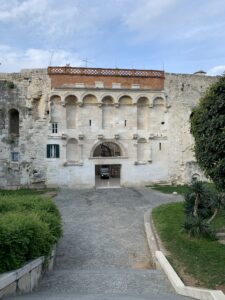
The beating heart of Split is the Diocletian Palace, a UNESCO World Heritage Site that has stood since 305 CE. The palace was built for as the retirement home for the Roman Emperor Diocletian when he abdicated rule to his hand picked successor, and it stood as a military fort and home to the elite to centuries after his death. The palace walls are still standing but much of the traditional palace inside is lost – but what is still there is a marvel to see. Traces of precise and regimented Roman city planning can be found under the modern buildings and medieval winding city streets. Curbs marking the wide Roman roads can still be seen in shops that have spilled over into the streets. Columns built to signify the Roman square are now a part of Renaissance residences. Relics from Egypt and every corner of the Roman Empire have become decorations for apartments, cafes and retail shops. This old man has stories to tell, and if you’re not careful you may be lured into listening until sunrise.
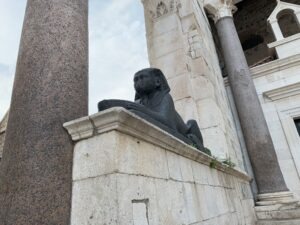
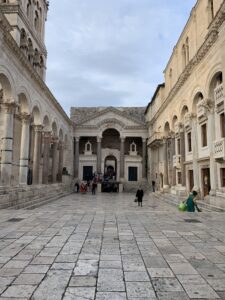
Because there is so much to see and so many tales to hear, to get the best grasp on what this old man as seen, we suggest paying for a guided walking tour of the palace. We normally spring for the free (donation based) tours, but we couldn’t find a reputable one in Split, so we got a tour from www.splitwalkingtours.com and it was great. The old city has so much history that a 2 hour walking tour will only scratch the surface, but we found this was the best way to learn about the city, have places of interest pointed out, and get your bearings in the winding, crowded streets. The earlier the tour the better, because once the cruise ships start arriving and unloading the palace crowds will become very hard to handle.
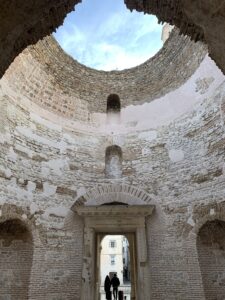
If you want to grab some great pictures of the palace, wake up early and enjoy the empty streets and warm embrace of a city waking up to greet the day. Like many old men, Split is an early riser as the city readies to take on the influx of tourists every morning. Vendors are preparing their shops, deliveries are being made and hustle is just beginning. But most importantly the crowds won’t have arrived yet, letting you get to know this mysterious old man in peace and quiet.
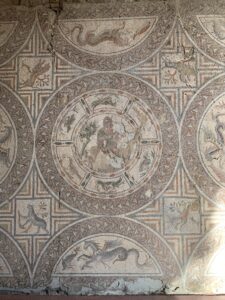
The Middle-Aged Maniac
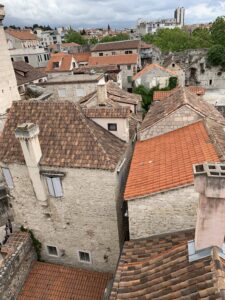
With the fall of the Roman Empire, the siege of nearby Saloma, and the spread of Christianity, the Diocletian Palace became a safe refuge for Medieval people. The walls of the palace offered safety from the warring tribes, and people from all over flooded the city streets seeking refuge. The wide Roman boulevards were soon overtaken by medieval houses crammed on top of each other, turning the palace into what more resembles the walled cities of Tuscany. Tight streets and narrow alleyways were created, making the well planned palace into a manic maze.
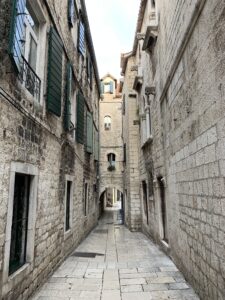
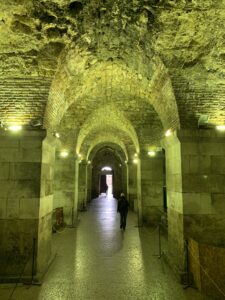
This era of unplanned and unrestrained growth in Split changes the character of the city entirely. While the old man town of the romans was orderly and precise, this manic phase gives Split its lived-character and the feel of a well loved home. Everything in the city was changed, for better and worse: the palace was stripped of its glory and became home to hundreds of residents, the temples to the Roman gods became Christian temples, and the mausoleum of Diocletian was desecrated and turned into a Cathedral. The cramped streets are at one beautiful and confusing as they twist and turn and sprawl throughout the tight walls, pushing up against their man-made confines. Eventually the medieval city burst through the city gates, spilling westward and and turning into a new person entirely: the Venetian Woman.
The Venetian Woman
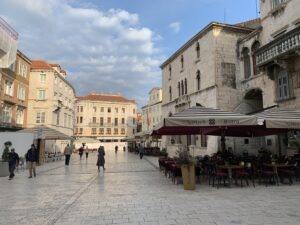
Classy and powerful, the Venetian Woman came to Split and brought the Italian Renaissance with her. The city once again went through a stunning era of change. Houses of wealthy merchants were built around piazzas that brought order to the manic medieval streets. The Venetian Woman walks the broadend boulevard with her head up high, a symbol of Split’s new stature are a Venetian trading hub and the Venetian connection to the Ottoman Empire and the East.
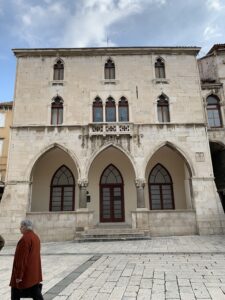
Splits new identity came with many new endeavors. The walls were reinforced to protect against potential attack. The spread of trade from Venice also brought a stronger bond of Catholicism, and many buildings were converted to churches, and the mausoleum was expanded to be a larger cathedral. The Venetian’s also found ways to incorporate the ancient Romans’ columns and architecture into new villas and homes for the merchant elite. It is the Venetian Woman’s constant struggle to bring a touch of class and refinement to a city lost in its own maze, and she performs her duty to this day with dignity.
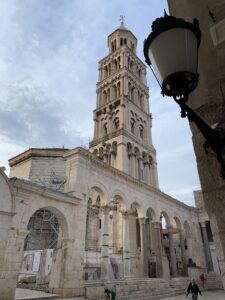
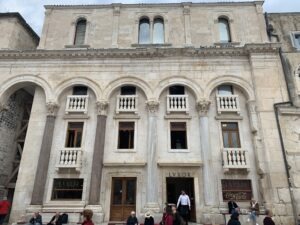
The Tourist

With the summer heat comes the Tourist to the city of Split. Like a fair weather friend, the Tourist is unreliable and flaky, swarming the city and packing the beaches. The Tourist fills in every alley way and claims every seat at the cafe, but never takes the time to really enjoy what Split has to offer. If you are going to be a tourist in this great city, here are a few tips for enjoying Split seeing all of her different personalities.
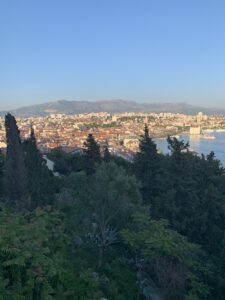
After you have explored the Diocletian Palace, get out of the walls. The palace is always crowded with tour groups and people who just got off the cruise ship, so it is best to go exploring during midday and take in the rest of Split. To the west of the city gates the town sprawls up the hill that over looks the city. A quick walk up the hill will give you great views of Split and you can take in the whole town.
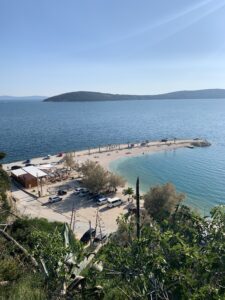
A little further west is Kasjuni Beach, one of the prettiest beaches in Split, and since its not right downtown, it is a little quieter and relaxing.
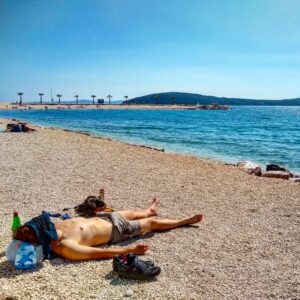
Explore the neighborhoods of Split, and take some time to enjoy a local festival or music. At the Diocletian Palace, the evenings are filled with music from the cafes and the main square becomes a beautiful performances area. The smaller neighborhoods also host neighborhood festivals and we stumbled on the St. Kriza festival where we got free dinner (grilled sardines) and free wine. Plus we got to dance the night away locals and hear some traditional Croatian music.
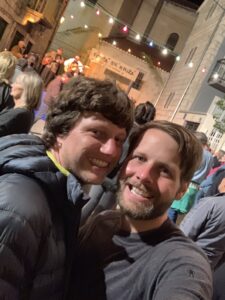
Overall, the Tourist can be noisy and boisterous and sometimes inconsiderate, but he also brings energy and life to the old city. Split wouldn’t be the same without him, and while he’s enjoyable sometimes it’s good to get out of his way and try and find a bit of Split that he hasn’t infested.
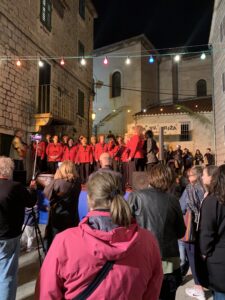
The Riva Diva
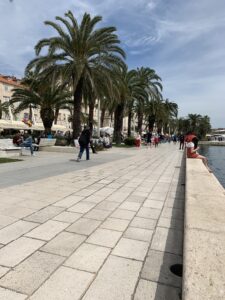
Along the waterfront is the main promenade filled with cafes. And sitting in those cafes under the umbrella and a bigger hat is the Riva Diva. She is the Venetian Woman’s younger sister, sleek and waiting to be seen out in public. She has all of the latest gossip and news, as soon as the clock strikes noon, her espresso turns into a cool glass of Dalmatian wine.
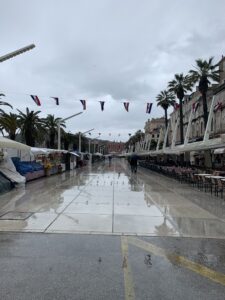
The Riva is an important part of any seaside town in Croatia and provides a social gathering place. It also acts as an entrance to the city for the people coming from the islands and cruise ships. In Split, the Riva is also the festival grounds and hosts parades like St Dominus Day and the scrappy Gay Pride Parade (where only a couple years ago people threw rocks and rotten food at the marchers). The Riva is the gathering place, a place where locals and tourists alike come out to enjoy the sun and some coffee. It is a place where a tiny cup of espresso lasts 3 hours and gossip flows like water to the Adriatic. Yes, the Riva Diva knows what you did last night, and is happy to remind you and everyone else about it.
The Collector

Outside the North wall of The Diocletian Palace is a statue of Gregory of Nin, a priest who fought for Croatian statehood and culture. But, the important thing about the statue is its big toe. Legend has it that if you rub the big toe you will come back to Split in the future. This is Split as The Collector, the collector of people and cultures and personalities that invites you in and makes you want to stay.
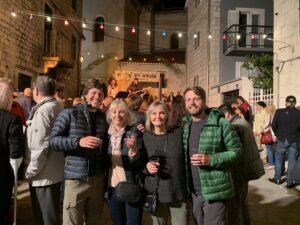
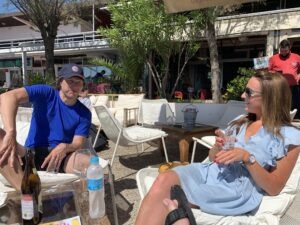
While we were in Split, we met and made friends with an amazing community of expats that had moved to Split, each for their own reasons, but all because they had fallen in love with the city. There is the South African chef, who is now the lead chef at a small cafe called Zeru who dreams of opening her own cake shop. There is the retired Canadian travel writer and accountant, who spent her life traveling and seeing the world and ended up falling in love with Split. An Irish pharmacist, who spends the summer months in Ireland pushing pills and the winter in Croatia enjoying the warm Adriatic winters and biking the on island trails. Then there’s the on-line law librarian from the U.K. who’s status as a digital nomad means she can take her work anywhere and decided the best place was the cafes of Split. The city is also home to Canadian-American burlesque dancer who moved to Split for a fresh start. And of course there is the native Croatian woman who performs symbolic wedding ceremonies celebrating the natural and spiritual beauty of Split and her Islands. Yes, the collector has been busy bringing all these people together, and it is his hard work that makes Split feel vibrant and young and full of life, even after millennia have past.
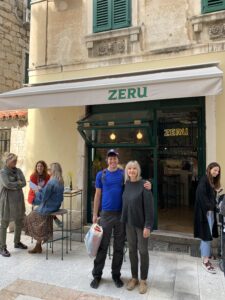
And personally, it’s all of Split’s personalities that make me want to join the collection. And who knows, maybe one day I’ll be back for good. I did rub the toe, after all.
